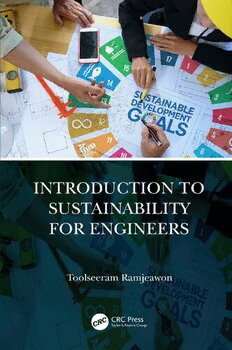
Introduction to Sustainability for Engineers PDF
Preview Introduction to Sustainability for Engineers
Introduction to Sustainability for Engineers Introduction to Sustainability for Engineers Toolseeram Ramjeawon CRCPress Taylor&FrancisGroup 6000BrokenSoundParkwayNW,Suite300 BocaRaton,FL33487-2742 ©2020byTaylor&FrancisGroup,LLC CRCPressisanimprintofTaylor&FrancisGroup,anInformabusiness NoclaimtooriginalU.S.Governmentworks Printedonacid-freepaper InternationalStandardBookNumber-13:978-0-367-25445-2(Hardback) This book contains information obtained from authentic and highly regarded sources. Reasonable efforts have been made to publish reliable data and information, but the author and publisher cannot assume responsibility for the validity of all materials or the consequencesoftheiruse.Theauthorsandpublishershaveattemptedtotracethecopyright holders of all material reproduced in this publication and apologize to copyright holders if permission to publish in this form has not been obtained. If any copyright material has not beenacknowledgedpleasewriteandletusknowsowemayrectifyinanyfuturereprint. Except as permitted under U.S. Copyright Law, no part of this book may be reprinted, reproduced, transmitted, or utilized in any form by any electronic, mechanical, or other means, now known or hereafter invented, including photocopying, microfilming, and recording, or in any information storage or retrieval system, without written permission fromthepublishers. For permission to photocopy or use material electronically from this work, please access www.copyright.com (www.copyright.com/) or contact the Copyright Clearance Center, Inc. (CCC), 222 Rosewood Drive, Danvers, MA 01923, 978-750-8400. CCC is a not-for-profit organization that provides licenses and registration for a variety of users. For organizations that have been granted a photocopy license by the CCC, a separate system of payment has beenarranged. TrademarkNotice:Productorcorporatenamesmaybetrademarksorregisteredtrademarks, andareusedonlyforidentificationandexplanationwithoutintenttoinfringe. LibraryofCongressCataloging-in-PublicationData Names:Ramjeawon,Toolseeram,author. Title:Introductiontosustainabilityforengineers/ToolseeramRamjeawon. Description:BocaRaton:CRCPress,[2020]|Includesbibliographicalreferencesandindex. Identifiers:LCCN2019042492(print)|LCCN2019042493(ebook)|ISBN9780367254452 (hardback;acid-freepaper)|ISBN9780429287855(ebook) Subjects:LCSH:Environmentalengineering.|Sustainableengineering.|Engineeringdesign. Classification:LCCTA170.R362020(print)|LCCTA170(ebook)|DDC620.0028/6–dc23 LCrecordavailableathttps://lccn.loc.gov/2019042492 LCebookrecordavailableathttps://lccn.loc.gov/2019042493 VisittheTaylor&FrancisWebsiteat www.taylorandfrancis.com andtheCRCPressWebsiteat www.crcpress.com To my family – for always being there for me – and to my students – for the motivation to inspire a sustainable world Contents Preface ........................................................xiii Acknowledgments ...............................................xv AbouttheAuthor...............................................xvii Contributors ................................................... xix 1. SustainableDevelopmentandRoleofEngineers................. 1 1.1 Introduction ...........................................1 1.2 WhyandWhatIsSustainableDevelopment? ...............1 1.3 TheSDGs,ParisAgreement,andRoleofEngineering.......15 1.4 SustainableDevelopmentandtheEngineeringProfession ...22 1.5 KeyAttributesoftheGraduateEngineer..................24 1.6 Summary.............................................24 SustainableEngineeringinFocus .............................. 25 References.................................................. 27 Exercises................................................... 28 RecommendedReadingandWebsites .......................... 31 2. SustainableEngineering:Concepts,Principles, andFrameworks ............................................ 33 2.1 Introduction ..........................................33 2.2 KeyConceptsforSustainableEngineering.................33 2.2.1 Factor4andFactor10:theGoalsof Sustainability .................................34 2.2.2 SystemsThinking..............................35 2.2.3 LifeCycleThinking ............................35 2.2.4 TheCircularEconomy..........................36 2.2.5 IndustrialEcology .............................38 2.2.6 GreenEconomyandLow-CarbonEconomy .......39 2.2.7 TheNaturalStep ..............................39 2.2.8 ResourcesEfficiencyandDecoupling .............40 2.2.9 Eco-efficiency .................................41 2.2.10 TripleBottomLine.............................41 2.3 GuidingPrinciplesforSustainableEngineering ............42 2.4 FrameworksforSustainableEngineering..................46 2.5 Summary.............................................52 SustainableEngineeringinFocus .............................. 53 References.................................................. 55 vii viii Contents Exercises................................................... 56 RecommendedReadingandWebsites .......................... 58 3. ToolsforSustainabilityAssessment........................... 61 3.1 Introduction ..........................................61 3.2 ProceduralTools ......................................63 3.2.1 EnvironmentalManagementSystem..............63 3.2.2 EnvironmentalAuditing........................64 3.2.3 CleanerProductionAssessment..................65 3.2.4 EnvironmentalImpactAssessment...............68 3.2.5 StrategicEnvironmentalAssessment..............71 3.2.6 LifeCycleManagement.........................71 3.2.7 DesignforSustainability........................72 3.2.8 SustainableProcurement........................73 3.2.9 StakeholderEngagement........................74 3.2.10 CSRandSustainabilityReporting ................75 3.2.11 Eco-LabelingandEnvironment ProductDeclaration............................76 3.2.12 BuildingsandInfrastructureRatingSystems.......77 3.2.13 Backcasting...................................78 3.3 AnalyticalTools.......................................79 3.3.1 BasedonPhysicalMetrics.......................79 3.3.1.1 LifeCycleAssessment .................79 3.3.1.2 Carbon,Water,andProduct EnvironmentalFootprints ..............80 3.3.1.3 MaterialFlowAccounting ..............81 3.3.1.4 EnvironmentalRiskAssessment.........82 3.3.1.5 GreenInfrastructureValuation..........83 3.3.2 BasedonNonphysicalMetrics...................84 3.3.2.1 StakeholderAnalysis ..................84 3.3.2.2 CostBenefitAnalysis ..................85 3.3.2.3 EnvironmentalLifeCycleCosting (E-LCC)..............................85 3.3.2.4 SocialLifeCycleAssessment............86 3.3.2.5 LifeCycleSustainabilityAssessment.....86 3.3.2.6 Multi-criteriaAnalysis .................87 3.3.2.7 SystemDynamics .....................88 3.4 Summary.............................................89 SustainableEngineeringinFocus .............................. 90 References.................................................. 92 Exercises................................................... 93 Contents ix 4. FundamentalsofLifeCycleAssessment ...................... 105 4.1 Introduction–WhyandWhatIsLCA? ..................105 4.2 TheLCAMethodology................................107 4.2.1 TheLCAGoalandScopeDefinition .............109 4.2.2 LifeCycleInventory...........................112 4.2.3 LifeCycleImpactAssessment ..................115 4.2.4 InterpretationandPresentationofResults........125 4.2.5 TheIterativeNatureofLCA....................126 4.2.6 MethodologicalChoices .......................127 4.2.7 LCIDatabasesandLCASoftwares ..............130 4.2.8 StrengthsandLimitationsofLCA...............131 4.3 EnvironmentalLifeCycleCosting,SocialLifeCycle Assessment,andLifeCycleSustainabilityAssessment .....132 4.3.1 Introduction .................................132 4.3.2 EnvironmentalLifeCycleCosting...............132 4.3.3 SocialLifeCycleAssessment ...................133 4.3.4 LifeCycleSustainabilityAssessment ............134 4.4 LCAApplicationsinEngineering .......................134 4.4.1 EnvironmentalProductDeclarationsandProduct CategoryRules...............................134 4.4.2 CarbonandWaterFootprinting.................135 4.4.2.1 CarbonFootprinting..................135 4.4.2.2 WaterFootprinting ...................136 4.4.3 EnergySystems ..............................136 4.4.4 BuildingsandtheBuiltEnvironment ............141 4.4.5 DrinkingWaterSupplyandWastewater Treatment ...................................142 4.4.6 SolidWasteManagement......................143 4.4.7 ChemicalsandChemicalProduction.............143 4.4.8 AutomotiveIndustry..........................144 4.4.9 FoodandAgriculture .........................144 4.4.10 ElectronicsandInformationandCommunication Technologies(ICT)............................144 4.5 Summary............................................145 SustainableEngineeringinFocus ............................. 146 References................................................. 154 Exercises.................................................. 156 RecommendedReadingandWebsites ......................... 160 5. IntroductiontoEnvironmentalEconomics..................... 163 5.1 Introduction–WhatIsEnvironmentalEconomics? ........163
